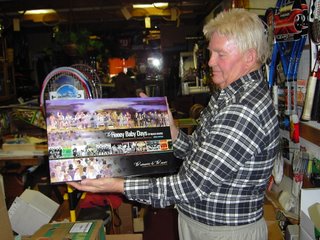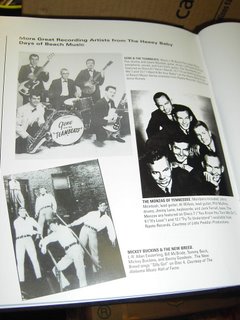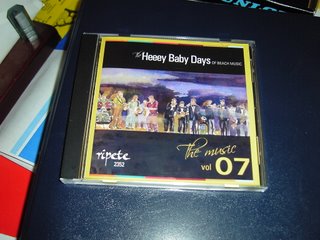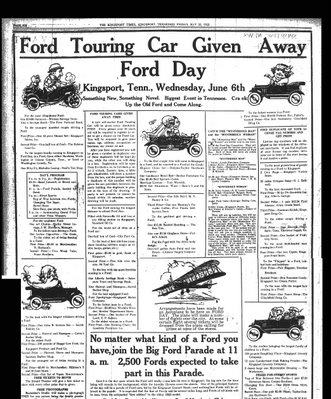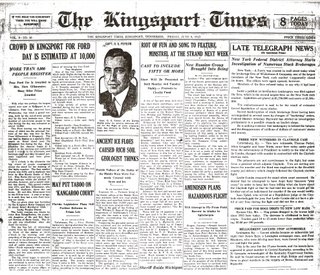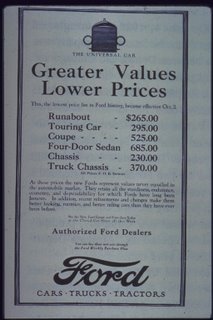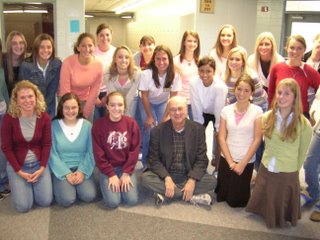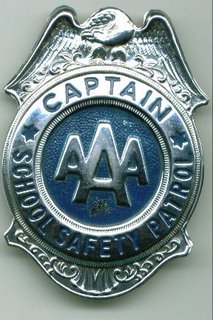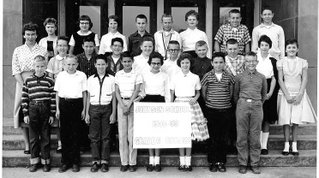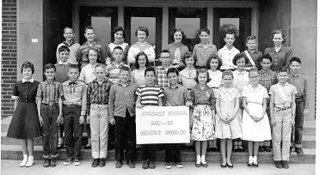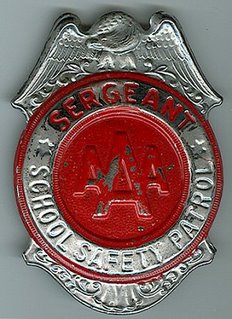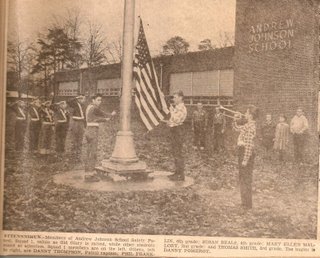Doris was a remarkable lady. She died over the weekend. Here is the column I wrote about her two and a half years ago.
Originally published on March 27, 2004
Doris Jean brought deaf culture to Kingsport's mainstream
When Doris Jean Robinson Cox graduated from Dobyns-Bennett in 1951, she was in a class of her own - the very first deaf student to graduate from the local high school.
Half a century later, she's still in a class of her own, a pioneer in bringing deaf culture to Kingsport's mainstream. Quietly, of course, but effectively.
Doris Jean was born in 1932 in an upstairs apartment at the corner of Main and Cherokee. That's correct. She was born there. "It wasn't until 1937 that they delivered babies at Holston Valley Hospital," she says. Her father, Amos Robinson, owned the garage downstairs. He used it for his business, Robinson Moving, a company he'd started in 1925 to move people who got jobs at Eastman.
Her father had met her mother when he was hired to move their family to Kingsport. Doris Jean says her mother was not taken with him. "My mother didn't really like my father at first. She had graduated from Radford and been teaching in Russell County, and she thought he was just a truck driver. She didn't know he owned the company."
Doris Jean's mother returned to Virginia to finish out the school year. "She was teaching and he went into her schoolroom and sat there and listened. He stayed and stayed and stayed. She said she married him to get rid of him."
They hadn't been married long when Doris Jean's mother discovered she was pregnant. A year after their wedding, Mr. and Mrs. Amos Robinson welcomed Doris Jean into the world.
Old Dr. Yancey came by the house to deliver her. Nine months later her mother was at the doctor's office, concerned that her baby girl might be deaf. Doris Jean says, "He told her, ‘Yeah, she's deaf.' They thought it might have been from a high fever I had when I was six months old." Doris Jean says her mother and father were heartbroken. But that didn't keep them from wanting the best for their daughter.
"My mother asked Dr. Yancey, ‘How can she get an education? She's a smart little girl.' Dr. Yancey drove to Nashville and talked to the Board of Education. That's when he found the Deaf School in Knoxville." At age four, Doris Jean packed her little suitcase and headed to Knoxville to begin her education.
She spent the next 10 years boarding at the Tennessee School for the Deaf, learning all the subjects other school kids learned, plus signing, the hand language of the hearing impaired.
She left TSD after the 10th grade. "My mother felt I was ready for the hearing world." After two summer school sessions, she finally entered D-B in the fall of 1949.
And as you might expect, it was an adjustment.
"Deaf school was like the Army. Discipline, discipline, discipline, walk in a straight line. At Kingsport High there was lots of freedom." And that included living at home instead of a dorm.
She calls her years at Dobyns-Bennett wonderful years. She went to classes with the other kids. She was treated like everyone else. Oh there was that dressing down from Miss Springer, the study hall teacher, who gave Doris Jean a good shaking for not paying attention, not knowing that the reason Doris Jean hadn't obeyed her command was because she hadn't heard her command.
The only thing Doris Jean missed from deaf school was basketball. She had been on the girls' team but discovered D-B didn't have any girls' sports. She says her old deaf school coach drove to Kingsport to convince her to come back where she could play basketball. But Doris Jean had moved into a new world.
And that's where she met Charles Cox. He was working for her father at his new business, Robinson Studebaker. He picked up Doris Jean and her brothers Harold and Johnny for an errand.
"My, he was very good looking."
That night at the supper table she asked her father, "Who in the world was that young man?"
She says her father responded, "‘ That's Charles Cox' and then he told me what a wonderful man he was. He was a fighter pilot in the war. He went to UT. He really built him up. The next two years I worked and worked and worked to catch him."
They married shortly after her high school graduation. Soon Doris Jean and Charles, who was not deaf, had two sons of their own. She raised her sons but she didn't neglect herself. In 1977, she graduated summa cum laude from ETSU with a degree in art. "And she didn't even have an interpreter," says her grandson Chad Cox, who served as interpreter for this interview. "She read lips and copied notes."
She didn't stop there. She finished graduate school in 1983 and then flew to Bolivia where she spent five weeks studying Bolivian weaving with Indian tribes. She visited Indian villages, studied their art, slept outside and ate Indian cooking.
Her art has stayed with her. Her Colonial Heights home is decorated with her handiwork, from an old Robinson Studebaker Co. bookcase that she refinished to an entryway wallpaper based on her own design.
Charles Cox passed away eight years ago shortly after their 45th wedding anniversary. She says it was hard for the first three years, but she has adapted. Just as she has adapted to everything thrown her way in life. Grandson Chad, who stays with her, says, "She was the key to opening deaf culture in Kingsport." It was Chad, not Doris Jean, who told me how she was responsible for bringing closed captioning to Kingsport television, how she served as the role model for the deaf students at Dobyns-Bennett after her, how she led the way as the first deaf student at ETSU.
Doris Jean Robinson Cox proved that being deaf in a hearing world is a challenge not a handicap.
